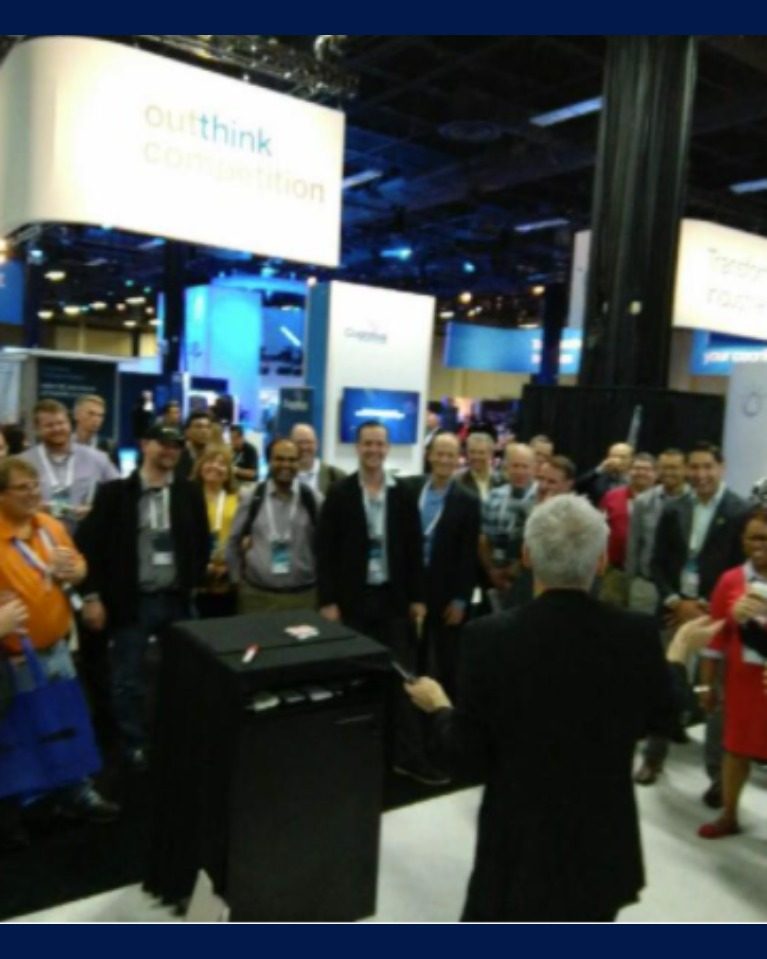As virtual trade shows make way for hybrid events this summer, we are sure to see some changes on the trade show floor. While we of course can’t be 100% certain of what these events will look like as we continue to adapt to this “new normal”, we do have some predictions about the future of trade shows as companies and associations navigate how to hold these enormous in-person events safely.
So, what will the future of trade shows look like? Here are our 5 predictions of what we can expect in 2021:
Health Precautions
Here’s how the World of Concrete is going to do it with 60,000+ attendees in Vegas in early June.
Look for the following health and safety measures at shows:
- Temperature taking at entrances which will no doubt cause bottlenecks
- Contactless registration with staff behind Plexiglas barriers
- Social distancing signs — with sponsorships printed on them
- Masks required
Professional presenters like trade show magicians, jugglers and narrators will be important assets to booths who will find it harder than ever to attract attendees. Highly visual entertainment like interactive magic will be popular attractions in the exhibit hall.
What will be missing? Those long banquet tables with a spread of free food. ☹
Virtual Entertainment
As we can all remember, in March and April of 2020, nearly all trade shows were cancelled, postponed or were converted to virtual events. Creating a virtual exhibit booth was no easy trick. Marketing and communications execs had to learn new technology and new platforms to communicate the features and benefits of their brand.
While trade shows and meetings pivoted, performers who are often seen at these venues attracting passers-by to booths pivoted, too. Virtual magicians, virtual jugglers and virtual narrators appeared “like magic” at events, broadcasting from their studios to help increase engagement at virtual trade shows the same way they did for in person events.
What’s next for trade shows moving forward? Although virtual meetings struggled in the beginning, we’re predicting that these “hybrid” events will combine the new virtual component with the proven in-person experiential marketing approach for the foreseeable future. For example, we expect significantly more video cameras on the trade show floor than ever before. They’ll be capturing the action at highly visual exhibit booths that have socially distanced attendees gathered around. Live marketing approaches will be the key to getting the attention on the trade show floor. You’ll see professional narrators demonstrating products and talented presenters like interactive magicians who combine exhibitors’ marketing messages with their virtual magic tricks.
Continued Need for Experiential Marketing
With all of these changes, here are a few things that won’t change:
- The enthusiasm and excitement of an in-person experience.
- Attendees handling products. There is no better way to judge a product than picking it up and testing it out in a trade show booth.
- The power of a face-to-face interaction. Even with mask mandates in place for trade shows, attendees and exhibitors will get more business done when that business takes place in-person.
The main hurdle for trade show exhibitors to tackle this year will be attracting socially-distanced attendees to their booth. We’re predicting that they’ll rely on sure-fire pre-pandemic techniques and lead generation strategies. It’s all about experiential marketing. A live event calls for live experience in the booth. And in 2021, a live experience should also be one that works virtually as well as in-person, because we predict that these trade shows will be hybrid events with a virtual component throughout this year.
Hybrid Trade Shows
The shift from in-person to virtual trade shows during the pandemic proved a couple of things. First, it was possible to have large scale meetings of tens of thousands of attendees online. Second, it took some getting used to.
In the early fall of 2020 Tradeshowlogic.com, a trade show management firm, conducted a Virtual Event Satisfaction Survey. They found a lot of frustration and disappointment amongst attendees. People missed the in-person conversation and networking component of large gatherings.
But there were also benefits of these new virtual events. For example, survey responders liked the ability for trade show goers to see speakers and learn about new products without leaving their home or paying exorbitant travel expenses. The lack of travel need also led to an increase in attendees, so overall it was a win-win for attendees and the associations holding the events.
Going forward, we see a hybrid situation being commonplace. A magical combination of virtual and in-person experiences at trade shows. This will give attendees with limited time or budgets an opportunity to select seminars and exhibits to visit. And it gives the associations an opportunity to increase their base and bottom line.
The Size Of Events
When it comes to trade shows, size matters. Now more than ever.
As trade shows move from a virtual experience to a hybrid experience—one that combines the online element with an in-person, face-to-face component—we’ll see some hesitation to return to large gatherings.
Certainly one factor that will determine the success of these events is size. Will people return to trade shows? Of course they will—eventually. For the short term we see smaller events with less that 1,000 people going forward as early as the spring. Larger events, such as the World of Concrete and HIMSS each with 50,000+ attendees, will likely see a decrease of in-person attendees as they roll out this summer.
But, the attendees that do show up will be motivated buyers and it will be important for exhibitors to get an ROI on their booth by maximizing lead count. We’re predicting that booths will be utilizing live presenters such as narrators and corporate hybrid magicians who can perform both virtually and in-person.
Whether in person, hybrid, or online, one thing is clearly never going to change: the importance of creating a memorable experience in a trade show booth.

